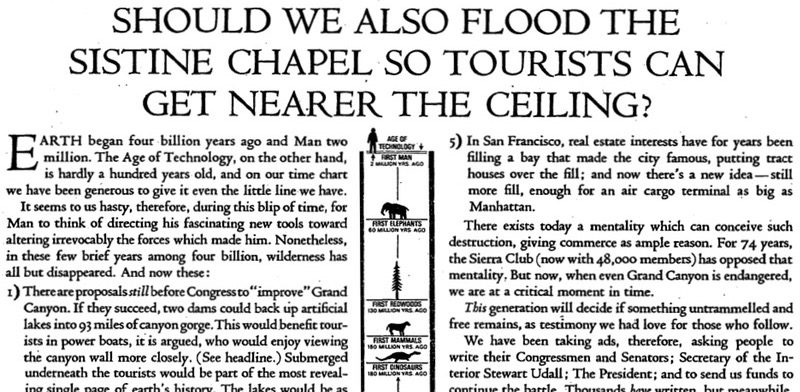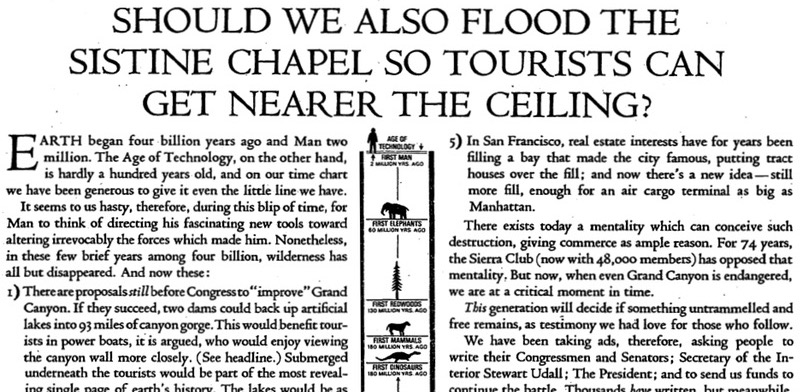I found a website, the other day, claiming that tax evasion in the US is roughly equivalent to 75 percent of the federal deficit — perhaps $600 million a year. Considering the fact that 80 percent of taxpayers have their tax payments withheld from their paychecks — and have their income reported directly to the IRS — it’s probably mainly self-employed entrepreneurs and wealthy folks living off their investments who are cheating on their taxes. That is to say, the people who have the most to gain are likely the ones lying about their tax obligations.
When it came to exaggerating the financial and environmental effects of federal water projects, it seemed like almost everyone at the US Bureau of Reclamation was willing to lie.
We ended Part Four on Friday with the statement that an overriding intention of the federal government, between 1902 and 1966, was to increase the settlement of the American West, and one of the key elements of their strategy was the construction of dams and reservoirs for flood control, irrigation, and hydroelectricity — not necessarily in that order of importance.
At least, that seemed to be their intention. In many cases, however, the projects planned by the US Bureau of Reclamation made no sense at all to a rational person, once you had the actual financial, hydrological and geological data laid out on the table. In those cases, the Reclamation engineers and bureaucrats did their best to obfuscate the facts… or simply lie about them.
A certain amount of such obfuscation took place in 1966, as the Bureau prepared to begin work on two new dams that would flood portions of the Grand Canyon (Bridge Canton Dam) and reduce the Colorado River through the national park to a mere trickle (Marble Canyon Dam).
They were two pieces of the ambitious Pacific Southwest Water Plan.
The Bureau also had plans to build the Central Arizona Project (CAP) — a 331-mile canal that would deliver water from Lake Havasu to Phoenix and Tucson and central Arizona — but needed funds to pay for the canal and to operate its massive pumping stations. Bridge Canyon and Marble Canyon were meant to provide hydroelectric power for the CAP. What the public was not told, however, was that the Bureau also planned to operate them as “cash register” dams, to raise money for a massive pipeline project starting at the Columbia River in Washington State, through a huge aqueduct that would one day serve to keep the Colorado River flowing, as the burgeoning populations of California, Arizona and Nevada did their best to drain the river dry. This enormous augmentation project — the Pacific Southwest Water Plan — was planned largely behind closed doors.

Fourteen years earlier, in 1952, a young mountain climber named David Brower had been hired as the only employee for the Sierra Club, a conservation-minded association headquartered in Berkeley, California. Following Brower’s efforts to stop the Echo Park Dam in Dinosaur National Monument, the club moved into national prominence, and when the plans to flood parts of the Grand Canyon were announced, Brower and the Sierra Club developed a national PR campaign to defeat the planned dams.
The Sierra Club campaign was helped out by the work of a young and relatively unknown New Mexico mathematician named Jeffrey Ingram, who had a fascination with two critical aspects of the proposed dams: the Grand Canyon itself and the fraudulent numbers being distributed by the Bureau of Reclamation. According to Ingram’s research, the CAP and the Bridge Canyon and Marble Canyon dams were going to be funded in part by the hydroelectric revenues coming from the already existing Hoover, Parker and Davis dams, once those dams had paid back their construction costs in the late 1980s. This was a violation of federal law. According to the law that created the Bureau of Reclamation, surplus power revenues were supposed to revert to the US Treasury, in order to compensate the taxpayers for forgiven interest obligations on Reclamation projects.
The other issue that Ingram discovered was that, because of the high cost of these new Colorado River projects, it would take literally decades for them to repay their construction costs using electricity sales and payments from irrigators and municipalities. So, by the time the projects were creating revenue that might be used to finance the Pacific Southwest Water Plan — to augment the Colorado River with water from the Columbia River, a thousand miles away — the Colorado River would probably be drained dry.
In some ways, the battle to defeat the Grand Canyon dams marked the ‘coming of age’ for America’s environmental movement. With the help of two prominent California advertising gurus, the Sierra Club took out full-page ads in the Washington Post, The New York Times, the San Francisco Chronicle, and the Los Angeles Times. One of the ads in 1966 asked readers — rhetorically, of course — if we ought to flood the Sistine Chapel to allow tourist to get closer to Michelangelo’s paintings.

Concludes the advertisement:
This generation will decide if something untrammeled and free remains, as testimony we had love for those who follow.
We have been taking ads, therefore asking people to write their Congressmen and Senators; Secretary of the Interior Stewart Udall; the President; and to send us funds to continue the battle. Thousands have written, but meanwhile, Grand Canyon legislation still stands a chance of passage. More letters are needed and much more money, to help fight the notion that Man no longer needs nature.
The ad included a form that could be cut out and enclosed when you mailed your money to the Sierra Club.
A generation did respond, as did the media. Reader’s Digest — a publication not generally known for its progressive tone — attacked the proposed dams. So did Life magazine.
“Then we got plastered by My Weekly Reader,” explained Reclamation staffer Dan Dreyfus, as quoted in Marc Reisner’s remarkable 1986 book, Cadillac Desert. “You’re in deep shit when you catch it from them. Mailbags were coming in by the hundreds, stuffed with letters from school kids…”
The Marble Canyon Dam officially died in 1968 when President Lyndon Johnson signed a law creating the Marble Canyon National Monument. Bridge Canyon remained on the drawing board until its official demise in 1984.
What these Bureau of Reclamation defeats indicated was not only the overreach of the Bureau and the ungodly increase in the cost of dam construction and water projects in general, but also the growing influence of the environmental movement. America had been happy, for almost 200 years, to trample the natural environment — landscapes, plant and animal species, and especially free-flowing rivers — in the name of human settlement in places where settlement required us to plunder the environment for relatively short-term profit.
America, it seems, was slowly coming to its senses in 1966. But not quickly enough to stop the Central Arizona Project.

